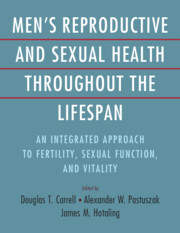 Men's Reproductive and Sexual Health Throughout the Lifespan
Men's Reproductive and Sexual Health Throughout the Lifespan Book contents
- Men’s Reproductive and Sexual Health throughout the Lifespan
- Men’s Reproductive and Sexual Health throughout the Lifespan
- Copyright page
- Contents
- Contributors
- Preface
- Section 1 An Introduction to Men’s Health Care
- Section 2 The Biology of Male Reproduction and Infertility
- Section 3 Clinical Evaluation and Treatment of Male Infertility
- Chapter 12 Office Evaluation of the Infertile Male
- Chapter 13 Medical Management of Male Infertility
- Chapter 14 Surgical Management of Male Infertility
- Chapter 15 Varicocele Repair in the Era of IVF/ICSI
- Chapter 16 Implementing Genetic Testing of Male Infertility in the Clinic
- Chapter 17 Andrological Care of the Patient with Spinal Cord Injury
- Chapter 18 Clinical Fertility Preservation Decision-Making for Prepubertal and Postpubertal Individuals with Male Gametes
- Chapter 19 Mental Health Considerations in the Infertile Male and Couple
- Section 4 Laboratory Evaluation and Treatment of Male Infertility
- Section 5 Medical and Surgical Management of Issues of Male Health
- Index
- References
Chapter 13 - Medical Management of Male Infertility
from Section 3 - Clinical Evaluation and Treatment of Male Infertility
Published online by Cambridge University Press: 06 December 2023
- Men’s Reproductive and Sexual Health throughout the Lifespan
- Men’s Reproductive and Sexual Health throughout the Lifespan
- Copyright page
- Contents
- Contributors
- Preface
- Section 1 An Introduction to Men’s Health Care
- Section 2 The Biology of Male Reproduction and Infertility
- Section 3 Clinical Evaluation and Treatment of Male Infertility
- Chapter 12 Office Evaluation of the Infertile Male
- Chapter 13 Medical Management of Male Infertility
- Chapter 14 Surgical Management of Male Infertility
- Chapter 15 Varicocele Repair in the Era of IVF/ICSI
- Chapter 16 Implementing Genetic Testing of Male Infertility in the Clinic
- Chapter 17 Andrological Care of the Patient with Spinal Cord Injury
- Chapter 18 Clinical Fertility Preservation Decision-Making for Prepubertal and Postpubertal Individuals with Male Gametes
- Chapter 19 Mental Health Considerations in the Infertile Male and Couple
- Section 4 Laboratory Evaluation and Treatment of Male Infertility
- Section 5 Medical and Surgical Management of Issues of Male Health
- Index
- References
Summary
Male factors significantly contribute to the issues faced by couples who are experiencing difficulties with conception. Management of the infertile male is complicated and based on a multitude of factors. Each couple is unique and has diverse issues, necessitating unique interventional approaches. Management can range from the optimization of lifestyle factors to treatment with surgery and medications. Several options exist in the medical optimization of the infertile, or subfertile male including treatment with gonadotropins (HCg, FSH), selective estrogen receptor modulators (i.e., clomiphene citrate), aromatase inhibitors (i.e., arimidex, letrozole), and prolactin altering agents (i.e., dostinex, bromocriptine). The use of the agents, both alone and in combination, is detailed in the current chapter.
- Type
- Chapter
- Information
- Men's Reproductive and Sexual Health Throughout the LifespanAn Integrated Approach to Fertility, Sexual Function, and Vitality, pp. 106 - 112Publisher: Cambridge University PressPrint publication year: 2023


